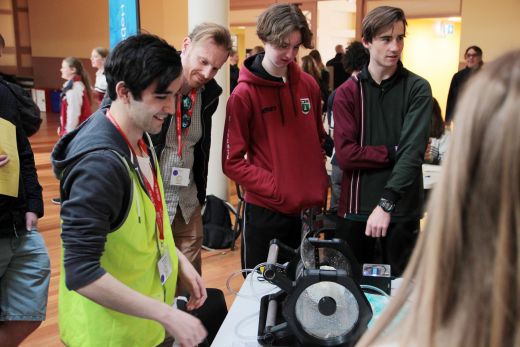
More than 1200 local Year 9 and 10 students have been battling it out, in the only Science and Engineering Challenge to be held in Australia this year since the COVID-19 outbreak.
Due to the pandemic, Tasmania was the sole location to host seven live, face-to-face competitions.
These attracted aspiring scientists and engineers from 47 schools, consisting of an almost even split between public and private, and a male to female ratio.
The national outreach program, which is supported by the University of Tasmania, commenced in Hobart on Tuesday, 15 September, before travelling to Launceston and then Burnie.
This year’s Challenge saw students engaging in activities that included creating a cost-effective bionic hand, building a model water turbine, making a model hovercraft and designing codes to send messages along fibre optic rods.
State Coordinator Susie Haley from the University’s College of Sciences and Engineering said it was tremendous that the competition went ahead.
“The Science and Engineering Challenge has been the only event endorsed by the University to involve students in a large-scale activity this year, with each day of the competition attracting around 200 participants,” Mrs Haley said.
“It aims to open students’ eyes to the possibilities that STEM creates for them as future careers by allowing them to discover that it involves creativity, teamwork, thinking outside the square and problem-solving.
“For some students, participation in the competition will spark their lightbulb moment of thinking ‘hey, I can actually do this, and maybe I should consider a career path in this area’.”
Out of a possible 1600 points, Launceston Christian School topped this year’s competition scoreboard with 1546.47.
Smithton High meanwhile was the only team in the State to design a bridge capable of enduring the bridge-busting finale, where increasing amounts of ‘gold ingots’ are rolled across the models to test their resilience.
“Given there are no ³Ô¹ÏÍøÕ¾s this year, we didn’t have heats which culminate in a State Final where the winner goes on to represent Tasmania,” Mrs Haley said.
“Instead, every day has been a competition within itself, and every school that has won is a Champion.
This year’s Science and Engineering Challenge would not have been possible without the generous time donation of over 2100 volunteer hours.
“About 50% of our volunteers are Rotarians, and the other 50% are made up from industry. We’ve had people from our major sponsor TasWater, as well as Hydro, TasNetworks, engineering firms, Australian Botanical Resources, DFR, local councils, Caterpillar and others, as well as UTAS and AMC students and Alumni,” Mrs Haley said.
“The support from industry is so important. Students can talk to these people about where they have been, where they are, learn about pathways, understand what they do within their industries, and how it all relates to STEM.”
Scorecards from this year’s Science and Engineering Challenge can be accessed at:
The Science and Engineering Challenge has been presented by the University of Newcastle, in partnership with The University of Tasmania, Tasmanian Government, TasWater and the Rotary Clubs of Tasmania.






